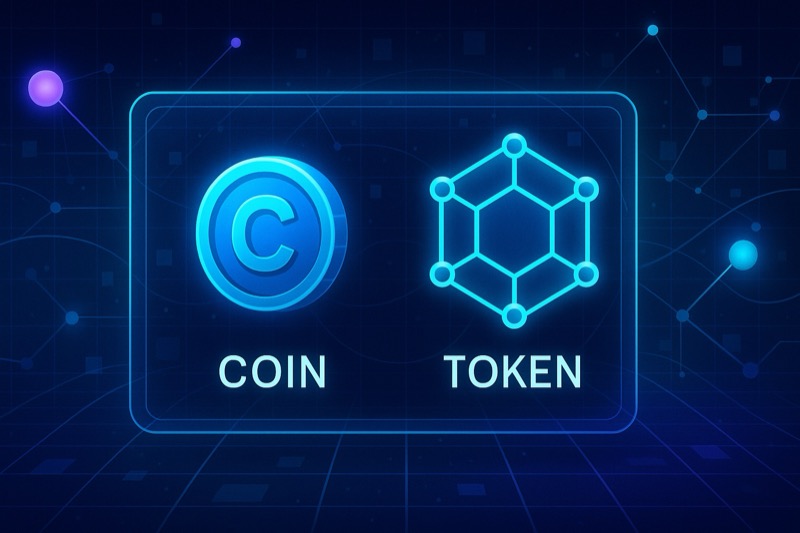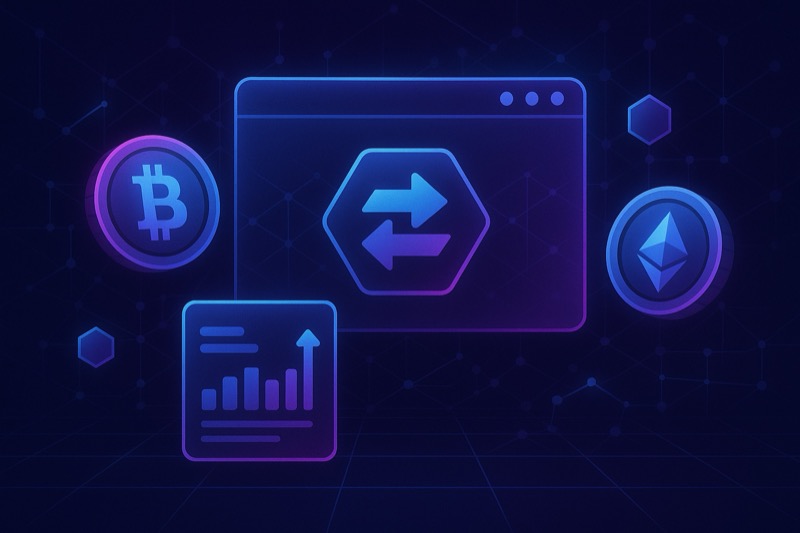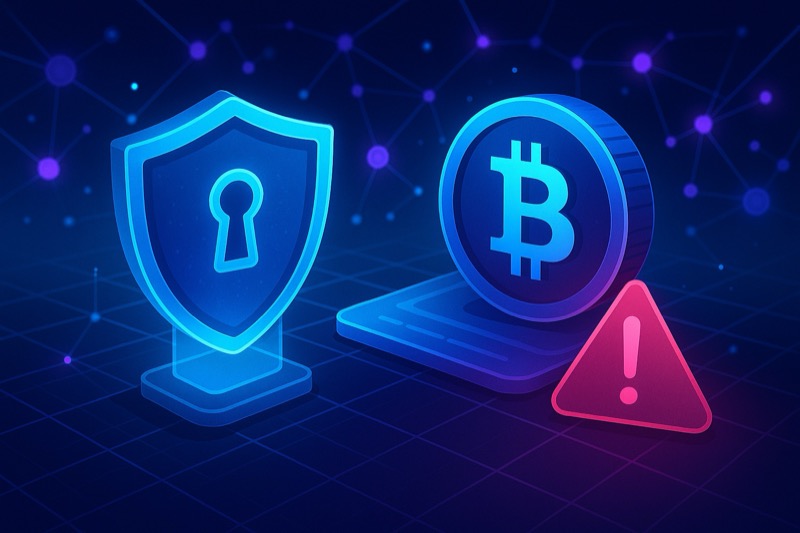Understanding Cryptocurrency: A Comprehensive Guide to Coins vs Tokens and Their Impact on Blockchain Technology
The growth of cryptocurrency has significantly changed the way we look at money, transactions, and the entire financial system. This decentralization shift is not without its own terms and intricacies, notably the concepts of "coins" and "tokens." While the two are often used interchangeably, they have different meanings and uses in the crypto ecosystem.
Understanding the distinction between these fundamental elements of cryptocurrency is essential for anyone looking to invest, trade, or participate in the blockchain revolution. In this comprehensive guide, we'll explore everything you need to know about coins and tokens, their differences, use cases, and their impact on the future of finance.
What Are Cryptocurrency Coins?
In the cryptocurrency world, "coins" or "cryptocoins" are digital assets that are native to their own blockchain. These coins function similarly to physical currency and can be used as a store of value, a medium of exchange, or a unit of account.
Key Characteristics of Cryptocurrency Coins:
1. Native Blockchain Operations Coins operate on their own independent blockchain networks. Each coin has its own infrastructure, consensus mechanism, and network of validators or miners.
2. Primary Functions
- Store of Value: Like gold or traditional currency, coins hold and preserve value over time
- Medium of Exchange: Used for transactions, purchases, and value transfer
- Unit of Account: Measure of value within their respective ecosystems
3. Examples of Major Cryptocurrency Coins
Bitcoin (BTC)
- The Original Cryptocurrency: Launched in 2009 by Satoshi Nakamoto
- Blockchain: Bitcoin blockchain
- Primary Use: Digital gold, store of value, peer-to-peer transactions
- Market Position: Largest cryptocurrency by market capitalization
Ethereum (ETH)
- Smart Contract Platform: Beyond currency, powers decentralized applications
- Blockchain: Ethereum blockchain
- Primary Use: Fuel for DeFi, NFTs, and smart contract execution
- Innovation: Introduced programmable blockchain functionality
Ripple (XRP)
- Enterprise Solution: Designed for cross-border payments
- Network: RippleNet
- Primary Use: Fast, low-cost international money transfers
- Target Market: Financial institutions and banks
Other Notable Coins
- Litecoin (LTC): "Silver to Bitcoin's gold," faster transaction times
- Cardano (ADA): Research-driven blockchain with proof-of-stake consensus
- Polkadot (DOT): Multi-chain network enabling blockchain interoperability
- Binance Coin (BNB): Native coin of Binance Smart Chain ecosystem
Why Cryptocurrency Coins Matter
One key feature of coins is that they are often used in a similar way to traditional money — for purchases, transactions, or as a long-term investment. Cryptocoins also tend to have wide acceptance, with many businesses and individuals recognizing their value and utility.
Advantages of Cryptocurrency Coins:
- ✅ Independent blockchain infrastructure
- ✅ Established network effects and security
- ✅ Wide acceptance and liquidity
- ✅ Direct ownership of value
- ✅ Often viewed as safer investments within crypto
- ✅ Can be used for staking and earning rewards
- ✅ Foundation for entire blockchain ecosystems
What Are Cryptocurrency Tokens?
Unlike coins, tokens are not native to their own blockchain. Instead, they are built on an existing blockchain infrastructure, such as Ethereum, and serve various functions beyond just holding value. Tokens represent a utility or a contract for almost anything, from physical objects to services to other cryptocurrencies.
Key Characteristics of Cryptocurrency Tokens:
1. Built on Existing Blockchains Tokens leverage the infrastructure, security, and consensus mechanisms of established blockchain networks.
2. Diverse Functionalities
- Utility Tokens: Grant access to services or products within a specific ecosystem
- Security Tokens: Represent ownership in real-world assets or companies
- Governance Tokens: Provide voting rights in decentralized organizations
- Stablecoins: Pegged to fiat currencies for price stability
- Non-Fungible Tokens (NFTs): Unique digital assets representing ownership
3. Examples of Popular Cryptocurrency Tokens
Chainlink (LINK)
- Type: Utility Token
- Blockchain: Ethereum
- Primary Use: Powering decentralized oracle networks
- Function: Connects smart contracts with real-world data
Uniswap (UNI)
- Type: Governance Token
- Blockchain: Ethereum
- Primary Use: Decentralized exchange protocol governance
- Function: Voting rights on protocol changes and improvements
Tether (USDT)
- Type: Stablecoin
- Blockchain: Multiple (Ethereum, Tron, BSC, etc.)
- Primary Use: Price-stable cryptocurrency pegged to USD
- Function: Trading pair, value preservation, remittances
Other Notable Tokens
- USD Coin (USDC): Regulated stablecoin backed by dollar reserves
- Shiba Inu (SHIB): Meme token with community-driven ecosystem
- Wrapped Bitcoin (WBTC): Bitcoin token on Ethereum for DeFi use
- Aave (AAVE): DeFi lending protocol governance token
Understanding Token Standards
One of the most well-known types of tokens is ERC-20 tokens, which adhere to a specific standard so that they can easily interact with other ERC-20 tokens on the Ethereum network.
Popular Token Standards:
ERC-20 (Ethereum)
- Most widely adopted token standard
- Defines rules for fungible tokens
- Easy integration with wallets and exchanges
- Powers majority of DeFi applications
ERC-721 (Ethereum)
- Standard for Non-Fungible Tokens (NFTs)
- Each token is unique and non-interchangeable
- Used for digital art, collectibles, gaming assets
BEP-20 (Binance Smart Chain)
- Equivalent to ERC-20 on BSC
- Lower transaction fees
- Faster transaction speeds
- Growing DeFi ecosystem
SPL (Solana)
- Solana's token standard
- Extremely fast and low-cost
- Emerging DeFi and NFT ecosystem
Other blockchains, like Binance Smart Chain, Polkadot, and Solana, have their own token standards, enabling developers to create diverse applications and use cases.
Why Cryptocurrency Tokens Matter
Tokens often fuel a project's ecosystem, representing things like voting rights within that ecosystem or a digital representation of an asset. They enable innovation, democratize access to services, and create new economic models.
Advantages of Cryptocurrency Tokens:
- ✅ Faster and cheaper to create than new coins
- ✅ Leverage established blockchain security
- ✅ Diverse use cases and functionalities
- ✅ Enable innovative DeFi applications
- ✅ Represent real-world assets digitally
- ✅ Facilitate community governance
- ✅ Lower barrier to entry for projects
Coins vs Tokens: Understanding the Key Differences
Let's break down the fundamental differences between coins and tokens:
Infrastructure
Coins:
- Operate on their own independent blockchain
- Require their own network of validators/miners
- Full control over protocol and consensus mechanism
Tokens:
- Built on existing blockchain platforms
- Rely on host blockchain's security and infrastructure
- Follow standardized protocols (ERC-20, BEP-20, etc.)
Primary Purpose
Coins:
- Primarily serve as digital currency
- Focus on value transfer and storage
- Act as the fuel for their native blockchain
Tokens:
- Serve diverse purposes beyond currency
- Represent assets, utilities, or rights
- Enable specific functionalities within ecosystems
Creation Complexity
Coins:
- Require building an entire blockchain from scratch
- Need to establish network security and consensus
- Significant technical expertise and resources required
Tokens:
- Can be created using smart contracts
- Leverage existing blockchain infrastructure
- Faster and more cost-effective to launch
Use Cases
Coins:
- Peer-to-peer transactions
- Store of value (digital gold)
- Network security (staking, mining)
- Gas fees for blockchain operations
Tokens:
- Access to DeFi services
- Governance and voting rights
- Representing real-world assets
- Gaming and NFT applications
- Loyalty and reward programs
Investment Considerations
Coins:
- Generally viewed as more established
- Often considered safer investments
- Subject to network adoption and usage
- Value tied to blockchain utility
Tokens:
- Higher risk, higher potential reward
- Success tied to project execution
- Subject to regulatory uncertainty
- Value depends on ecosystem growth
Significance of the Difference for Investors
Understanding the distinction between coins and tokens is crucial for investors and participants in the crypto space. This differentiation helps in making informed decisions based on the utility, potential value, and risk associated with each type of digital asset.
Investment Strategy: Coins
Advantages:
- More established market presence
- Greater liquidity and trading volume
- Lower risk of project abandonment
- Clearer regulatory landscape
- Independent blockchain security
Considerations:
- May have slower growth compared to tokens
- Limited utility beyond value transfer
- Competition from newer blockchain technologies
- Regulatory scrutiny on major coins
Best For:
- Conservative crypto investors
- Long-term holders ("HODLers")
- Those seeking digital store of value
- Portfolio foundation and stability
Investment Strategy: Tokens
Advantages:
- Higher growth potential
- Diverse investment opportunities
- Access to innovative DeFi projects
- Lower entry barriers
- Specific use case alignment
Considerations:
- Higher risk of project failure
- Regulatory uncertainty
- Dependence on host blockchain
- Token economics and inflation
- Smart contract vulnerabilities
Best For:
- Risk-tolerant investors
- Those interested in specific ecosystems
- DeFi and NFT enthusiasts
- Diversification within crypto portfolio
Risk Management
While coins typically offer a relatively safe investment (in the context of the generally risky crypto market) and are often seen as "digital gold," tokens can provide a broader range of potential benefits. However, they also carry additional risks, such as:
Token-Specific Risks:
- Project failure or abandonment
- Regulatory crackdowns on specific use cases
- Smart contract bugs or exploits
- Token supply inflation
- Team mismanagement
- Market manipulation
- Liquidity issues
Risk Mitigation Strategies:
- Diversify across coins and tokens
- Research project fundamentals thoroughly
- Understand tokenomics and supply schedules
- Monitor project development and community
- Use reputable exchanges like X4T
- Never invest more than you can afford to lose
Real-World Applications and Use Cases
Coins in Action
1. Bitcoin: Digital Gold
- Store of value during economic uncertainty
- Cross-border remittances without intermediaries
- Hedge against inflation
- Institutional adoption as reserve asset
2. Ethereum: Smart Contract Platform
- Powering decentralized applications (dApps)
- Enabling DeFi lending and borrowing
- NFT marketplace infrastructure
- Enterprise blockchain solutions
3. Binance Coin: Ecosystem Fuel
- Reduced trading fees on Binance
- Participation in token sales (Launchpad)
- Payment for BSC transaction fees
- Staking and yield farming
Tokens in Action
1. DeFi Tokens
- Lending protocols (Aave, Compound)
- Decentralized exchanges (Uniswap, SushiSwap)
- Yield aggregators (Yearn Finance)
- Liquidity provision rewards
2. Governance Tokens
- Voting on protocol changes
- Treasury fund allocation
- Community-driven development
- Decentralized autonomous organizations (DAOs)
3. Stablecoins
- Trading pair on exchanges
- Remittances and payments
- DeFi collateral
- Salary and freelance payments
4. Utility Tokens
- Access to platform services
- Discounted fees
- Premium features
- Exclusive content or products
The Future of Coins and Tokens
As the world of cryptocurrency continues to evolve and mature, the distinction between coins and tokens will become increasingly significant. Here's what to expect:
Emerging Trends
1. Interoperability
- Cross-chain bridges enabling token transfers between blockchains
- Multi-chain tokens existing on multiple networks
- Universal token standards
2. Regulatory Clarity
- Clearer distinctions between security and utility tokens
- Compliance frameworks for token issuance
- Institutional adoption of compliant assets
3. Tokenization of Real-World Assets
- Real estate tokenization
- Stock and bond representations
- Commodities and precious metals
- Art and collectibles
4. Advanced Token Economics
- Deflationary token models
- Dynamic supply adjustment
- Algorithmic stablecoins
- Value capture mechanisms
5. Integration with Traditional Finance
- Central Bank Digital Currencies (CBDCs)
- Institutional custody solutions
- Regulated crypto products
- Mainstream payment integration
Innovation Drivers
The true potential of both coins and tokens lies in how they are harnessed by developers, investors, and users:
For Developers:
- Creating innovative DeFi protocols
- Building scalable blockchain solutions
- Designing sustainable token economics
- Improving user experience
For Investors:
- Diversified crypto portfolios
- Active participation in governance
- Yield farming and staking
- Long-term value creation
For Users:
- Accessible financial services
- Ownership and control of assets
- Participation in digital economies
- Global payment solutions
How X4T Supports Your Crypto Journey
At X4T Exchange, we provide comprehensive support for both coins and tokens, ensuring you have access to:
Trading Platform Features
- Wide Asset Selection: Trade major coins and popular tokens
- Advanced Security: Fireblocks-powered wallet protection
- Low Fees: Competitive rates on BSC infrastructure
- High Liquidity: Deep order books and liquidity pools
- Fast Execution: Lightning-fast trade processing
Educational Resources
- 24/7 Multilingual Support: Get help in English, Spanish, or German
- Comprehensive Guides: Learn about coins, tokens, and blockchain
- Market Analysis: Stay informed with expert insights
- Trading Tutorials: Master crypto trading strategies
Security and Compliance
- KYC Verification: Secure and streamlined onboarding
- Regulatory Compliance: Operating within legal frameworks
- Asset Protection: Institutional-grade security measures
- Insurance Coverage: Additional protection for your funds
Conclusion: Mastering the Crypto Ecosystem
Understanding the difference between cryptocurrency coins and tokens is fundamental to navigating the digital asset landscape effectively. While both serve unique roles within the blockchain ecosystem, their distinct characteristics, use cases, and risk profiles make them suitable for different investment strategies and applications.
Key Takeaways:
✅ Coins are native to their own blockchains and primarily serve as digital currencies
✅ Tokens are built on existing blockchains and have diverse functionalities
✅ Both have unique advantages and risk considerations
✅ A diversified portfolio often includes both coins and tokens
✅ Understanding these differences enables better investment decisions
✅ The crypto ecosystem continues to evolve with new innovations
As the cryptocurrency market matures, the line between coins and tokens may blur with cross-chain technologies and innovative hybrid models. However, understanding these fundamental differences not only allows individuals to navigate the crypto world more effectively but also contributes to the broader understanding of this transformative technology.
Whether you're a seasoned investor or just beginning your crypto journey, X4T Exchange is here to support you every step of the way. Our hybrid exchange model combines the best of centralized security with decentralized freedom, offering you access to a wide range of coins and tokens in a secure, user-friendly environment.
Ready to start trading coins and tokens with confidence? Join X4T Exchange today and experience the future of digital asset trading with institutional-grade security, competitive fees, and 24/7 multilingual support.
Start Your Crypto Journey with X4T - Where Knowledge Meets Opportunity.




